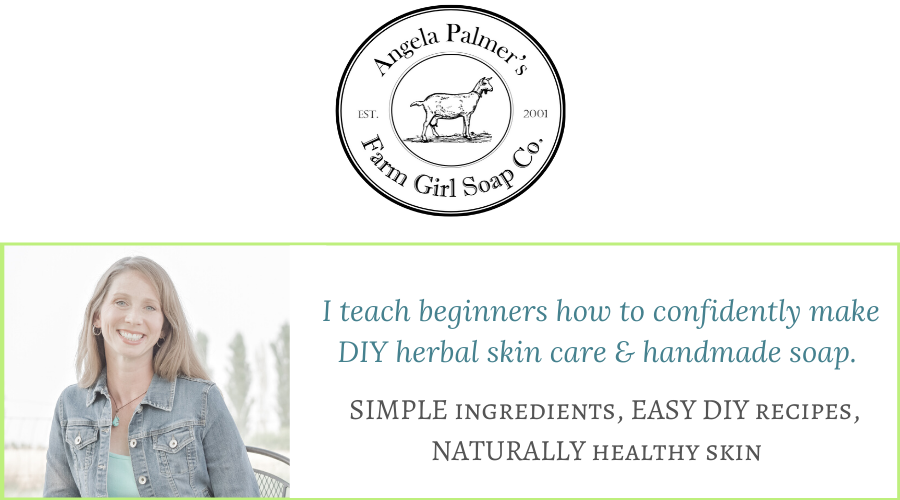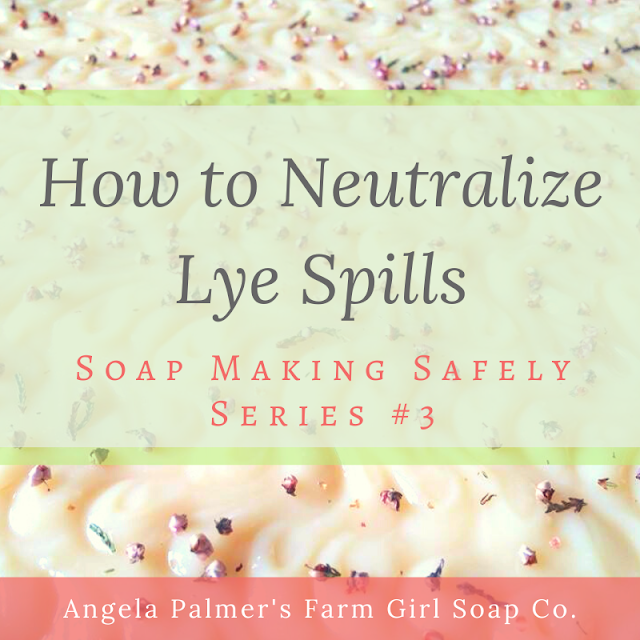Soap Making Safety: 7 Must-Know Rules for Using Lye Safely While Soap Making
This article is part 2 of the Farm Girl's Soap Making Safety Series. Check out part 1 and part 3.
I put off making my first batch of soap because I was terrified to death of lye.
When I finally built up the courage, I covered the entire kitchen in newspaper and opened every window because I heard lye gives off deadly fumes. I wore a long, heavy duty lab coat over my long-sleeved shirt and pants, rubber gloves that went up to my elbows and goggles I had snatched from the garage.
I was so certain that a cloud of noxious fumes was going to engulf the house, or that the lye water was going to melt my containers and quite possibly burst into flames, that I sent my husband and children out for the day.
By the time I finished that first soap batch, I realized that working with lye isn't all that scary.
The fear of lye is common among beginning soapers. Of course, lye is caustic and has to be handled carefully.
But as long as you use common sense, and follow a few safety rules, you'll be just fine. Pinky promise.
Here are seven must-follow rules for soap making with lye.
1. Use Only 100% Lye
The lye you use for making your soap must say 100% lye right on the package. If it isn't labeled such, don't use it. No exceptions.You can get 100% lye at most hardware stores. You can also buy lye online from soap making suppliers, where it's sold under its chemical name sodium hydroxide.
2. Wear Gloves and Protective Goggles
The lye crystals, lye water, and raw soap batter is caustic and can burn you. Rubber gloves and protective eye goggles are a necessity.Put your gloves and safety glasses on before you begin soap making and don't remove them until clean up is done.
Use gloves that you feel most comfortable in. I prefer nitrile or latex gloves (like what doctors use in the exam room) because they are thin and I can feel what I'm doing. You can get a box of nitrile gloves in the first aid aisle at the store for a few bucks.
There are other soapers who like the yellow rubber dish washing gloves instead. It's personal preference.
Goggles can be bought at the hardware store. Get a pair that wraps around the sides and under the eyes to best protect against splashes and splatters.
And no, your eye glasses won't protect well against splatters. There are goggles made especially to be worn over your regular eye wear so you can protect your eyes and still see what you're doing.
Save this article to Pinterest!
3. Always Pour Lye Into Water, NEVER the Other Way Around
Sprinkle lye into the water while gently stirring to ensure all crystals fully dissolve.Never pour water into the lye. Doing this creates a hard shell of partially dissolved lye encasing a pocket of undissolved crystals.
At best, you'll end up with undissolved lye in your finished soap. At worst, pressure will build up within the lye shell causing lye water to spit, spurt, or explode out of your container.
4. Don't Use Aluminum Pots or Utensils
Aluminum and lye react badly together. Soaping in an aluminum pot can cause pitting of your pot, and can throw off noxious fumes.I've also heard from a few soapers that mixing lye and aluminum creates a black smoke. I've not seen this personally, though I'm not about to experiment to find out.
Use stainless steel pots, rubber spoons, plastic pitchers and measuring cups, just no aluminum. Check the bottom of the pot for a "stainless steel" stamp if you're unsure.
5. Use Heat-Safe Plastic Containers for the Lye Water Mixture (Not Glass)
When you add the lye to your water, it will get really hot, nearly boiling. Make sure your lye water container can handle the heat without melting.Plastic pitchers that are stamped with the recycling #5 are durable enough and are inexpensive. They also make it easy to pour lye water without spilling.
If you're not sure your container is up for the task, fill it with plain boiling water first and check for melting or warping.
Be sure to set the container in the sink first, in the off chance it does melt the scalding water will go down the drain rather than all over your kitchen.
Don't use glass containers for your lye water. The rapid temperature shift can cause the glass to shatter.
Lye can also etch the glass over time, making it more likely to shatter while soaping.
6. Use Cold Water
Because lye heats the water so drastically, make sure you start off with cool water (it doesn't need to be icy, cold from the tap is fine).If your water is too warm before you add your lye, you can end up with water well past the boiling point. Boiling lye water equals scary stuff, friend!
7. Set Your Lye Water Container in the Sink
Before pouring the lye into the water, set the container down into the sink, and leave it here until you're ready to pour it into your soap pot. This way, if the container is accidentally knocked over it spills down the drain rather than your counter tops and floor. You definitely don't want to be mopping up hot lye water from your floors.While you're at it, consider putting your lye water container into a cold water bath. I usually just fill the sink half-full with water, throw in some ice cubes and let my lye water container sit in this.
This isn't technically a safety rule, but it sure makes working with the lye water much nicer. It helps tame the fumes and helps cool the lye water down much more quickly, so you can get on with making soap. Just make sure there isn't so much water in the sink that your container starts to float.
Check out the other posts in this Soap Making Safety Series:
- Lye Questions and Answers
- How To Safely Neutralize Lye and Handle Lye Spills
- How To Make Cold Process Soap
- Not Ready for Lye? Try This Oatmeal, Milk and Honey Soap - No Lye Recipe
A step-by-step printable guide for the cold process soap making method plus a lye handling safety checklist.
Enter your name and email and I'll send it to your inbox!






